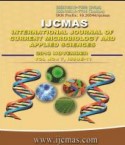


 National Academy of Agricultural Sciences (NAAS)
National Academy of Agricultural Sciences (NAAS)

|
PRINT ISSN : 2319-7692
Online ISSN : 2319-7706 Issues : 12 per year Publisher : Excellent Publishers Email : editorijcmas@gmail.com / submit@ijcmas.com Editor-in-chief: Dr.M.Prakash Index Copernicus ICV 2018: 95.39 NAAS RATING 2020: 5.38 |
Selections for quantitative traits are paramount importance to achieve the desired breeding objectives in breed evolving programmes through hybridization. In the light of the above, an experiment was conducted utilizing six different aboriginal silkworm races namely, C108, NB4D2, Pure Mysore (PM), Nistari, zebra and knobbed belonging to two voltinistic groups by rearing them under standard laboratory conditions for six different generations during three seasons of the year. At the parental generations (denoted as P1), the harvested cocoons were grouped into two batches wherein, one batch of cocoons were exposed to mass selection and another batch of cocoons were exposed to individual selection by recording data for four important traits namely, cocoon weight, shell weight, filament length and pupation rate. The pooled data was statistically analyzed for analysis of variance (ANOVA) and the results have clearly demonstrated that, the individual (Cellular) selection has resulted in higher increase in the three economic traits viz, cocoon weight, shell weight and filament length significant (P<0.05), wherein mass selection resulted in significant (P<0.05) improvement in pupation rate across six generations. The data also revealed that the selection response is high (>96%) during pre-monsoon season in multivoltine races than the bivoltine races. The obtained data will determine to understand the suitability of selection response for using in genetics and breeding programmes for the production of high yieldable and superior silk content silkworm breeds/hybrids. It is concluded with responses to selection hereby importance of two selection method is discussed in the light of silkworm selection and hybridization programmes.
 |
 |
 |
 |
 |